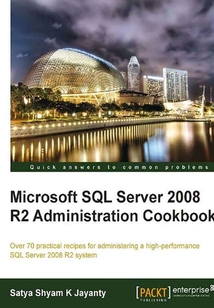舉報 

會員
Microsoft SQL Server 2008 R2 Administration Cookbook
最新章節:
Index
Thisbookofferspractical,task-based,andimmediatelyusablerecipescoveringawiderangeofadvancedtechniquesforadministeringahigh-performanceSQLServer2008R2system.Inadditiontoitscookbookstyle,whichensuresthesolutionsarepresentedinaclearstep-by-stepmanner,itsexplanationsgointogreatdetail,whichmakesitgoodlearningmaterialforeveryonewhohasexperienceinSQLServerandwantstoimprove.Thebookisdesignedinsuchawaythatyoucaneitherreaditchapterbychapterorrefertorecipesthatyouwantinnoparticularorder.AlthoughthebookisfocusedonspecificMicrosoftSQLServer2008R2,mostoftheconceptsandexplanationsarealsoapplicabletoSQLServer2008.Ifyouareanexperienceddatabaseadministratoranddatabasearchitectwhowantstodesign,administer,andmanageascalableandhigh-performanceSQLServer2008R2system,thenthisbookisforyou.Thebookassumesthatyouhaveagoodunderstandingofdatabasemanagementsystems,specificallyexperienceinMicrosoftSQLServer2008administration.
目錄(121章)
倒序
- 封面
- 版權信息
- Credits
- Foreword
- About the Author
- Acknowledgment
- About the Reviewers
- www.PacktPub.com
- Support files eBooks discount offers and more
- Preface
- What this book covers
- SQL Server 2008 R2 Prologue
- SQL Server 2008 R2 new enhancements
- SQL Server 2008 R2 DataCenter
- SQL Server 2008 R2 Parallel Data Warehouse
- What you need for this book
- Who this book is for
- Conventions
- Reader feedback
- Customer support
- Chapter 1. Getting Started with SQL Server 2008 R2
- Introduction
- Adding SQL Server 2008 R2 Service Pack features using Slipstream technology
- Designing a best practice approach to upgrading to SQL Server 2008 R2
- There's more.
- Working with Data-Tier applications
- Designing and adopting SQL Server 2008 R2 solutions
- Designing applications to use federated servers
- Chapter 2. Administrating the Core Database Engine
- Introduction
- Designing automated administration practices
- Implementing Security feature enhancements
- Implementing Availability feature enhancements
- Implementing Monitoring and Tuning for performance
- Administering SQL Server workloads with Resource Governor
- Designing SQL Server Agent scheduled jobs for ETL processes
- Troubleshooting multi-server instances with utility administration
- Administering SQL Server Replication processes
- Chapter 3. Managing the Core Database Engine
- Introduction
- Implementing Central Management feature enhancements
- Designing Multi-server management from SQL Server 2008 R2
- Managing the Utility Control Point data warehouse database
- Implementing Utility & Non-utility collection sets
- Designing and refreshing a Scalable Shared database
- Managing SQL Server Replication processes
- Implementing security for SQL Server Agent jobs management
- Multiserver Management Using Utility Explorer
- Chapter 4. Administering Core Business Intelligence Services
- Introduction
- Preparing and installing SQL Server Analysis Services
- Implementing Scale-Out of SQL Server Analysis Services
- Administering SQL Server Reporting Services
- Implementing Scale-Out deployment of SQL Server Reporting Services
- Preparing and installing SQL Server Integration Services
- Managing the ETL process efficiently
- Chapter 5. Managing Core SQL Server 2008 R2 Technologies
- Introduction
- Planning and implementing Self-Service Business Intelligence services
- Implementing Microsoft StreamInsight Technologies Platform
- Implementing SQL Azure connectivity features
- Installing and configuring a Master Data Services Solution
- Designing and deploying framework to use Master Data Services
- Chapter 6. Improving Availability and enhancing Programmability
- Introduction
- Preparing new Failover Cluster features
- Installing and configuring Failover Cluster Services
- Recovering and troubleshooting Failover Cluster Failure
- Implementing Database Mirroring features and performance enhancements
- Managing Database Mirroring in a Failover Cluster environment
- Managing Log Shipping scenarios in a Database Mirroring environment
- Improving Replication scalability at multiple sites
- Implementing compressed storage features for tables and indexes
- Designing a storage solution for unstructured data and new collations
- Designing data partitioning solutions for tables and indexes
- Implementing sparse columns and wide table features
- Designing spatial data storage methods
- Deploying and managing data-tier applications
- Chapter 7. Implementing New Manageability Features and Practices
- Introduction
- Implementing auditing and service level security features
- Managing server-level securable and database-level permissions
- Implementing backup compression for a VLDB environment
- Designing change tracking methodology
- Implementing Policy-Based Management features
- Implementing and running PowerShell for SQL Server features
- Implementing the SQL Server Best Practices Analyzer
- Designing Transparent Data Encryption features
- Chapter 8. Maintenance and Monitoring
- Introduction
- Implementing performance baseline practices
- Monitoring resource usage with Extended Events
- Implementing Management Data Warehouse features
- Designing maintenance tasks on a mission-critical environment
- Implementing Piecemeal restore strategies
- Planning and designing of a Disaster Recovery environment
- Implementing sustainable index maintenance practices for a VLDB & 24/7 environment
- Configuring a manageable database consistency and integrity process for multiple databases and a VLDB environment
- Configuring a server storage system for scalability
- Configuring SQL server storage architecture for quick recovery
- Managing a storage system for analyzing bottlenecks
- Chapter 9. Troubleshooting
- Introduction
- Implementing systematized monitoring methods for data platform optimization
- Designing a filtered indexes and statistics feature
- Implementing table hints for advanced query tuning performance
- Implementing query hints for optimized performance
- Designing sustainable locking methods to improve concurrency
- Implementing parallel query processing methods
- Implementing the plan guide to enhance compile-time and run-time execution plans
- Configuring and managing storage systems for optimized defragmentation processes
- Building best usage processes of Dynamic Management Views
- Implementing a benchmarking framework on multiple instances
- Chapter 10. Learning the Tricks of the Trade
- Introduction
- Automated administration across an enterprise
- Administrating resource health policies
- Administrating multiple Analysis Services using Tools
- Managing events capture to troubleshoot problems
- Appendix A. More DBA Manageability Best Practices
- Index 更新時間:2021-04-02 19:34:12
推薦閱讀
- 持續演進的Cloud Native:云原生架構下微服務最佳實踐
- Adobe Photoshop 網頁設計與制作標準實訓教程(CS5修訂版)
- 中文版SolidWorks 2015技術大全
- Photoshop CS5平面設計入門與提高
- SolidWorks 2021中文版機械設計從入門到精通
- Rhino 6.0中文版入門、精通與實戰
- Photoshop日系少女寫真后期解密
- jQuery Mobile First Look
- 邊做邊學:Photoshop+CorelDRAW綜合實訓教程
- AI繪畫:Stable Diffusion從入門到精通
- Photoshop+CorelDRAW平面設計實例教程(第4版)
- Google App Engine Java and GWT Application Development
- Microsoft Dynamics GP 2010 Reporting
- Photoshop CS6實戰從入門到精通(超值版)
- Photoshop CC 2017 淘寶美工設計實例教程
- PHP and MongoDB Web Development Beginner's Guide
- Vue.js實戰
- Photoshop CC2017圖像處理實例教程
- AI繪畫精講:Stable Diffusion從入門到精通
- JSF 1.2 Components
- 新編中文版Photoshop平面設計入門與提高(第2版)
- Magento 1.3: PHP Developer's Guide
- 剪映:短、中、長視頻剪輯全攻略(手機版+電腦版)
- Maya 2022從新手到高手
- 精通Microsoft 365云計算管理:SharePoint Online篇
- Oracle APEX 4.0 Cookbook
- 電商美工設計手冊
- 3ds Max/After Effects 印象 影視包裝技術精粹(第2版)
- Adobe After Effects CC 2019經典教程(彩色版)
- After Effects CC中文版完全自學教程

